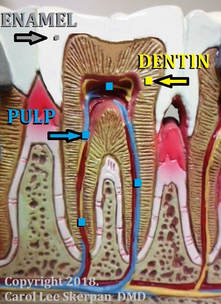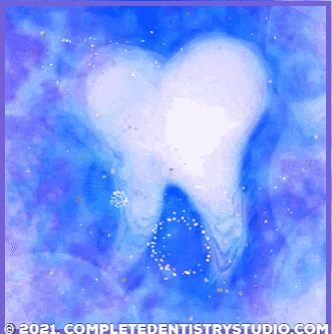
MUSCLES: ' In the last blog I kinda' liked our short side-trip to St Andrews Scotland. However, I am interested in getting back to dental-topics. So what is the "scoop" on the inside of the tooth? ' Dr Skerpan: Remember, both the TOOTH ITSELF must be healthy along with it's healthy surrounding PERIO-DONTAL STRUCTURES. Only with both being healthy can both efficiently & effectively function together. For now let's con- sider an important aspect of the TOOTH ITSELF---it's inner most part and what can happen to it. Anything involving this inside-area-of-the-tooth is referred to as "endo-dontics"--i.e., involving the "internal (inside)"-of-the-"tooth". First, let's review the makeup of the tooth. A TOOTH has one or more ROOTs (legs), depending on it's location in the mouth. The roots anchor the tooth into the bone. Making up the tooth's "anatomical" CROWN is the hard-outside-layer called the enamel--under the enamel is the dentin--and under the dentin layer is the soft-inside part of the tooth called the pulp. The pulp is made up of blood-vessels, nerves, odontoblasts (or "cells" that produce the layer of dentin) and connective-tissue. So the pulp serves the important func- tions of supplying blood for nutrients & moisture--nerves for signaling pain and proprioception ("feedback" & "sensing")--odontoblasts for producing the dentin layered in-between the enamel and pulp--and connective-tissue for supporting, binding, separating and connecting all these elements together within the tooth's pulp-chamber & canals (see pictures below). ______________________________________ MUSCLES: ' But why does the tooth need all of this production from it's pulp? Also, you said that the roots (legs) anchor the tooth into the bone--so what does the pulp's function have to do with the roots and bone? ' Dr Skerpan: Without proper "feeding & renewal" from the pulp, the tooth would become dry & brittle as "dead-bone". Like any bone in the body, the tooth ulti- mately functions as a "hard-structure". It needs to be "fed", renewed, nourished, resilient and "responsive" to it's surroundings. It functions as a strong hard struc- ture by the grace of the softer-structures serving it. The blood-vessels, nerves & odontotoblasts (dentin-producing cells) supply the nutrients, moisture, "feedback" and regeneration for the 2 inside layers of the tooth (pulp & dentin). Only with these supplies can the tooth remain vital---and continue as a living-structure within the body. And what does the pulp's function have to do with the roots and bone? The pulp- tissue thrives within the crown & root(s) of the tooth (see pictures below). The pulp-chamber is the "housing" for the pulp in the crown (top-part-of-the-tooth). The narrow root-canal system is the "housing" for the pulp-tissue inside each root. These root-canals serve to direct the blood-vessels and nerves to & from the pulp-chamber out to the bone. Through a small opening in the apex-tip- of-the-root, the blood-vessels & nerves can travel in and out thru' the root's tip. Outside the apex they join the bone's circulating blood & nerve supply. Dr Skerpan: Skin sloughs-off, as it is renewed from underneath. Hair grows in length &/or falls out, as it is renewed from underneath the skin. Nails grow out, as they are being renewed. Unlike these outside "dead-structures", a tooth does not renew it's entire self. The enamel (hard-outside-shell) does not fall off or get renewed! The pulp & dentin are the only living, dynamic parts of the tooth. The pulp & dentin, along with the tooth's outside surrounding PERIO-DONTAL STRUCTURES, are the only living-extensions & living-connections of the tooth to the whole rest of the entire body! MUSCLES: ' Huh-uh!!! 2 Questions please! First. Speaking of the living PERIO-DONTAL STRUC- TURES connected to the tooth---when we discussed the tooth's ROOT-to-BONE connection, the "perio-dontal ligaments" connected to the BONE. But what did they connect to on the ROOT-surface? If there is no enamel on the root-surface, is there something else covering the root's dentin? ' Second. The pulp & dentin is "alive", but is the enamel "alive"? '
Second. The enamel is not technically "alive", so it can not regenerate nor repair naturally. Therefore, the goal should be to protect, repair, reinforce and restore the crown's enamel (& dentin) back to it's healthy function as best as "humanly" possible. The enamel is the strongest material in the human body, and it needs to remain hard, strong and intact for the sake of chewing & speak- ing. However, it also must remain intact to protect the living pulp & dentin from "dying-off"! If the pulp & dentin "die-off" (become non-vital), the whole-tooth becomes dry & brittle. In addition, the dead "pulp-debris" sets up the scenario for an abscess to develop--also called a "dento-alveolar" abscess for "tooth-to- bone" abscess. As the pulp & dentin "die-off", the dead or dying "pulp-debris" develops a full bacterial infection within the tooth. This infection accumulates within the tooth, and continues out the apex-tip-of-the-root into the bone. The bone responds the same as the body would to any other "dead-debris" in the body. The bone "rejects, reacts to and retreats from" it, continuing it's own inflammation, break- down, infection (abscess) and "resorption" at & around the root apex. MUSCLES: ' It's a "Paws-to-Whiskers" moment! The bone resorbs or "eats" itself away again! The bone "eats away" if the tooth is not present--but the bone also "eats away" if the tooth "dies-off"! It's "the-bone-needs-the-tooth" AND "the-tooth- needs-the-bone" all over again! ' Dr Skerpan: That's right! The BONE (which is a part of the "perio-dontal sur- rounding structures" for the tooth) and TOOTH must co-exist, but individually both must be healthy for the relationship to work efficiently and effectively. The TOOTH must be healthy inside-and-out for the BONE---and the BONE must be healthy inside-and-out for the TOOTH . MUSCLES: ' So, what can happen to the tooth to cause the pulp to die? Can't the pulp be "fixed" like the crown's outside 2 layers of enamel & dentin--or be made healthy again? ' Dr Skerpan: In our next dental-blog, we will cover the common causes of "pulp- death"--and the "endo-dontic" treatment which can possibly give the tooth it's last chance to function within the bone. ********************************************************************************************************** **********************************************************************************************************
0 Comments
|
Author
|




























 RSS Feed
RSS Feed